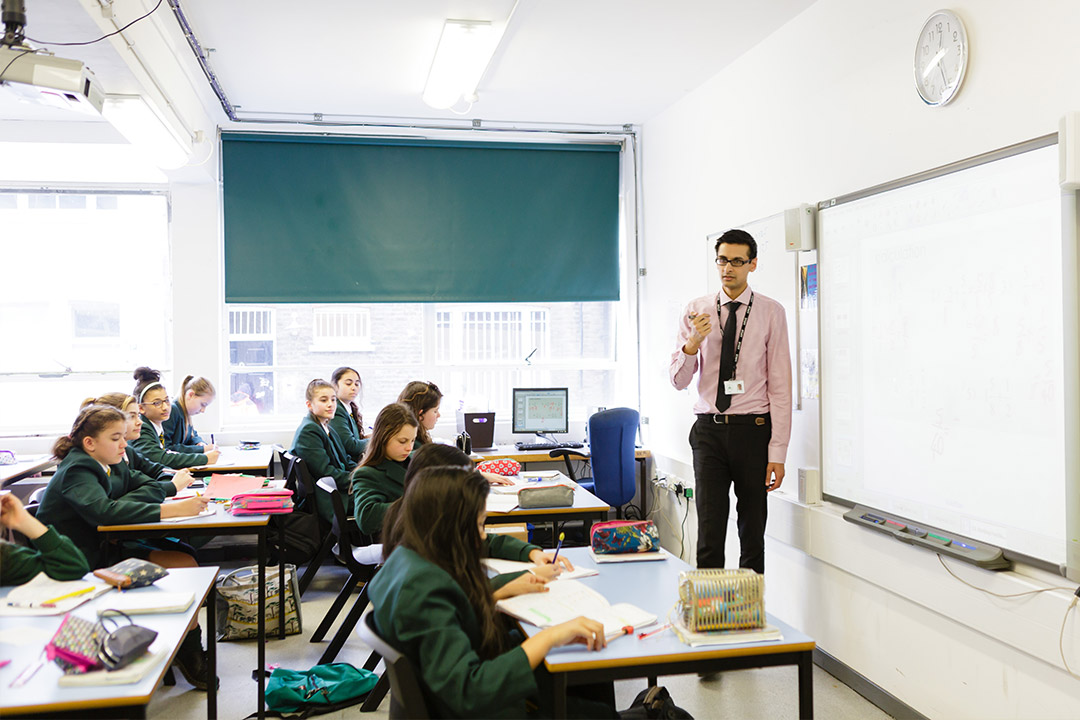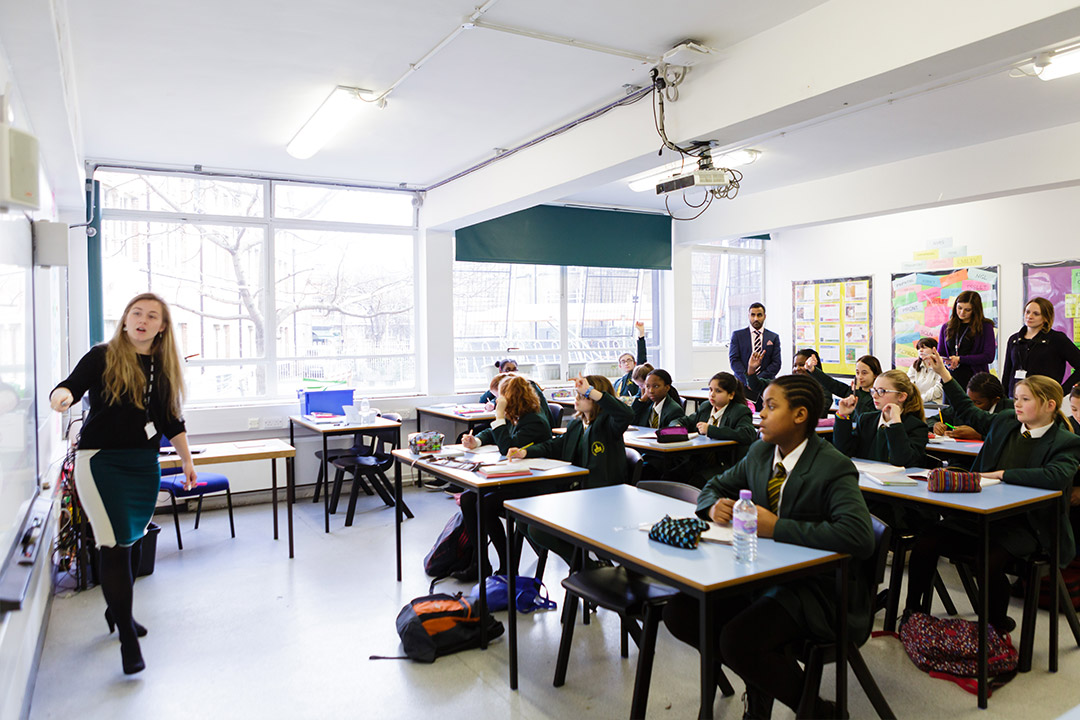Teacher collaboration supports mixed-attainment classes
A London school models one possible way to make the transition

Teaching for mastery and how we group students
Teaching for mastery begins with the premise that every child can succeed at mathematics. This principle runs counter to a ubiquitous cultural belief in this country, that some people just can’t do maths. Every maths teacher has had to diplomatically respond to the parent at parents’ evening who explains unashamedly, “Well, it’s no wonder he can’t do maths – I never could”. But the pervasiveness of our national belief in ‘those that can’ and ‘those that can’t’ do maths is not mirrored around the world – and is particularly different in those jurisdictions that top the international league tables.
If a school accepts that every child can succeed at maths, but that they will learn at different rates at different times, then the practice of placing children in 'ability' sets may be called into question. Being in a lower set often results in students believing that they are no good at maths, having access only to a restricted curriculum. They are also separated from their peers involved in higher-order thinking, exposure to which can really bring on lower attaining children. 'Ability' setting in schools does not occur in Shanghai, Singapore or many other high performing jurisdictions.
However, the prospect of introducing all-attainment groupings is a daunting one in most English secondary schools. All-attainment teaching has been on the fringes of maths education for long enough now that the large majority of secondary maths teachers have little or no experience of teaching all-attainment groups beyond the first few weeks of Year 7.
Many schools, beginning to be more familiar with practices in high-performing jurisdictions, are searching for models of successful transition to all-attainment grouping in the UK. Several primary schools have already taken the step into mixed groups, though arguably setting was far less entrenched at primary level. At secondary level, schools and teachers are beginning to wonder how it can be done. The model being developed at St Marylebone C of E School, Lead School for London Central and North West Maths Hub, is one example worthy of consideration.
The St Marylebone Model…
 St Marylebone’s first cohort to be taught maths in mixed attainment classes is now (2016/17 school year) in Year 8: the Year 7 cohort behind is also mixed. Making such a radical change, with little in the way of structure, resources, or teacher experience to support it, proved very challenging and the department almost reverted to setting. Then they got together for some joint planning and sharing of ideas. What began as a one-off idea has developed into a weekly meeting of teachers to plan all their lessons together and has resulted in a department hugely enjoying and committed to teaching mixed groupings. They have seen encouraging results in student progress, confidence and enjoyment.
St Marylebone’s first cohort to be taught maths in mixed attainment classes is now (2016/17 school year) in Year 8: the Year 7 cohort behind is also mixed. Making such a radical change, with little in the way of structure, resources, or teacher experience to support it, proved very challenging and the department almost reverted to setting. Then they got together for some joint planning and sharing of ideas. What began as a one-off idea has developed into a weekly meeting of teachers to plan all their lessons together and has resulted in a department hugely enjoying and committed to teaching mixed groupings. They have seen encouraging results in student progress, confidence and enjoyment.
…And how they got there…
Following participation in the Shanghai exchange in 2015, Maths Hub Lead and Head of Department Dan Chandrakumar was confronted with the dilemma of how to meaningfully introduce teaching for mastery at St Marylebone. He began with a few of the methods that had impressed him whilst in China, but felt that these were just tinkering around the edges in individual classrooms, and that meaningful implementation would involve more structural change.
In Shanghai, in non-setted classes, whole-class, teacher-led teaching is the norm. The entire class studies the same topic for a long period, so that no child is left behind. Those who grasp ideas quickly – and these are not the same students every time – are extended by being expected to explain their reasoning carefully and in depth. They are also challenged by tackling more difficult problems, and by an expectation that they must understand not only how to do a procedure, but also the mathematical structure behind the procedure. Those who have had difficulty with a topic are given same-day intervention so that they are ready to access the next lesson.
When Shanghai teachers visited and taught at St Marylebone last year (2015/16), the maths department decided to mix up their previously setted classes in Year 7 so that the visitors would have mixed attainment classes to teach. When the Chinese teachers left, a fortnight later, the department agreed that they wanted to continue where the Chinese teachers left off, to see how they got on. So in the run up to Christmas 2015, St Marylebone teachers had mixed attainment Year 7 classes and the willingness to see if they could make it work. It was a rude awakening to the complexities of all attainment teaching. Dan Chandrakumar describes the experience:
"We didn’t understand it enough when we started it, so a lot of it has been a learning journey, there have been mistakes. The ideology is that you take everyone with you, no one gets left behind, so we thought ‘let’s have mixed ability classes, and teach everyone, raise the bar’ and… yeah, it didn’t work at all, it was terrible. The teaching just didn’t match what was needed for mixed ability classes. All the teachers were teaching to the middle. The top end were bored, the lower end were struggling, and bored. Only the kids in the middle were enjoying lessons or making real progress. At that point we very almost went back to setting but we decided to try one more thing."
Reluctant to abandon the principle of having mixed classes too quickly, Dan suggested to his staff that they try joint planning on a regular basis and they agreed to give it a go. This idea is also modelled on standard practice in Shanghai where ‘Teacher Research Groups’ (TRGs) meet regularly to review and plan lessons. Year 7 teachers at St Marylebone started to meet weekly, to discuss progress in the current week’s teaching, and to outline lessons for the week ahead. Dan describes the revolutionary effect that this had on everybody’s teaching:
"We started doing the TRGs and the teaching quality just rocketed – previously we had had all these teachers who are busy as it is, having to plan four mixed ability lessons a week with no experience of what was required."
With the collaborative TRG work, teachers outline a plan together then divide up the detailed planning load so that they are only planning one or two lessons per fortnight in detail.
"Once the TRGs started, everyone was like ‘yes, this is the way we want to continue doing this’."
By the end of the school year, staff felt confident that they were effectively meeting the needs of all students in the classes and that students were making good progress. When Dan consulted staff, they resoundingly opted not only to repeat what they had done with the new Year 7, but to carry on into Year 8 with the first cohort. So now the school has all-attainment groupings in Year 7 and Year 8 with weekly TRG meetings to review and plan lessons. Whilst Dan has succeeded in getting the school to timetable teachers so that they all have a common non-contact period in which to attend the meetings, there is no extra time on timetables for the meeting. Effectively teachers are choosing to use their own PPA time to attend and are resoundingly positive about what a worthwhile use of this time it is.
Committing two hours a week (for those that teach both year groups) is a big ask of a busy teacher – it’s intriguing to know how Dan has managed it. But the teachers all appear to agree how their colleague Andrew Dowle sums it up:
"It seemed a lot at first, but it pays such huge dividends. It is actually a time-saver because you benefit so much from the joint planning."
Add this to the fact that they share a busy office: it is evident that the conversation begun in the allotted TRG hour is one that continues all week over cups of tea.
All-attainment grouping lends itself well to joint-planning. In a setted school, the teacher that teaches Set 2 of 8 may be following the same curriculum as other sets (or may not be) but very probably at a different pace, or in a different order, making collaborative discussion more difficult and joint planning impossible. In this model, all teachers of the year group have comparable classes and move through the same curriculum at roughly the same rate. It is easy to see that coming into the department office to let off steam about ‘that lesson’ (good or bad), is likely to get a more constructive response than just a sympathetic ear.
The TRG in action
Read a more detailed description of the TRG’s discussion on the day we visited.
Management support
To effect such structural change, the department must, clearly, have the support of the school management. At St Marylebone, this reform extends beyond the maths department. Following the successful implementation of maths TRGs, science and English departments have also started joint planning in a similar way. Removing sets has freed up timetable flexibility so that teachers can have the necessary common PPA period. Dan has also arranged for a cover teacher to be regularly timetabled for each year group. This frees staff, in rotation, to spend the period visiting all their colleagues’ classes to share good practice.
What other difficulties were encountered?
Because of the big curriculum changes that have been implemented at the school, it is impossible to compare the new cohort’s test results with data from previous years. Because the curriculum involves smaller steps and greater depth, with a slower pace and longer spent on each topic, the department have had to create different tests to reflect this.
The following diagram shows how the marks from the end of Year 7 tests spread out over the different classes. The letters in the left hand column are the classes, the numbers in the right hand column are the median (%) marks.
What teachers have noticed is that students are more engaged, enjoying maths more, and making better progress. Dan says:
"The kids that typically would have been in our support set, and by this stage hating maths and feeling bored and inadequate, just don’t feel like that now, because they are not in the support set. So one day they can be really good, and one day they can struggle and they are supported by the class."
And what about the students who would previously have been in the top set? How have they adapted to the changes? Dan reports that winning these students over has not always been easy:
"The trouble is, a lot of the stuff we do looks like really easy maths – for example commutative law and distributive law. The kids who’ve done well at primary school because they can carry out algorithms often feel like they are learning nothing new because they are not necessarily embracing what they are supposed to be learning. So that’s been a bit of a struggle."
He gives this example: 25 + 132 + 75
This is a sum that students well-schooled in algorithms might thoughtlessly carry out from left to right. However, the teaching point might be to look at the structure and use that understanding to recognise the possibility and efficiency of adding the 25 + 75 first.
"The kids are starting to get used to the idea – where there was a little bit of resistance from some kids, they are starting to understand that yes, it does get hard very quickly. I’ve been in cover lessons where kids have looked in GCSE books and realised that yes, with the depth, it’s beyond GCSE."
The apparently easy questions have also caused problems with some parents, particularly those who wonder why their child is not in the top set. Better communication with parents has been effective in securing parental support:
"This year we took the step of explaining the concept of mastery to all Year 7 parents at the Year 7 parents information evening: the setting, the ideology and how all that works. At parents' evening we only had around three parents who questioned what we are doing, so that was effective."
So where to next?
Dan is unsure but not vague. He is clear that he is trying something out and listening carefully to what his teachers are saying. There is no grand plan – he anticipates consulting with the department and finding out what colleagues think will work and are prepared to try. He is also very aware of the need to reconcile ideology with reality. Teaching for mastery approaches are patchy in primary schools so St. Marylebone receives Year 7 pupils who already have a huge spread of attainment when they arrive.
"Last year was experimental so we retained a small support set. This year we have tried to manage it without a support set – in an ideal world there would be no need for one. But we are beginning to accept that we may need to create one in Year 7 now."
Will the school carry the mixed attainment groups on into Year 9?
"I don’t know. We will evaluate as this year (2016/17) goes on. I’d be very happy if we did, but I will ask the teachers how they feel, how the students are doing. It was very obvious that they wanted to take it into Year 8. And from the data it seemed the best thing to do. Year 9 may be more difficult, but let’s wait and see…"
This case study was first published in 2017.
Read the NCETM Director’s blog post in which he suggests timetabling teachers to teach fewer year groups, a strategy that could enable the logistics of collaborative planning, and lighten teachers’ planning load.
Read blog post

